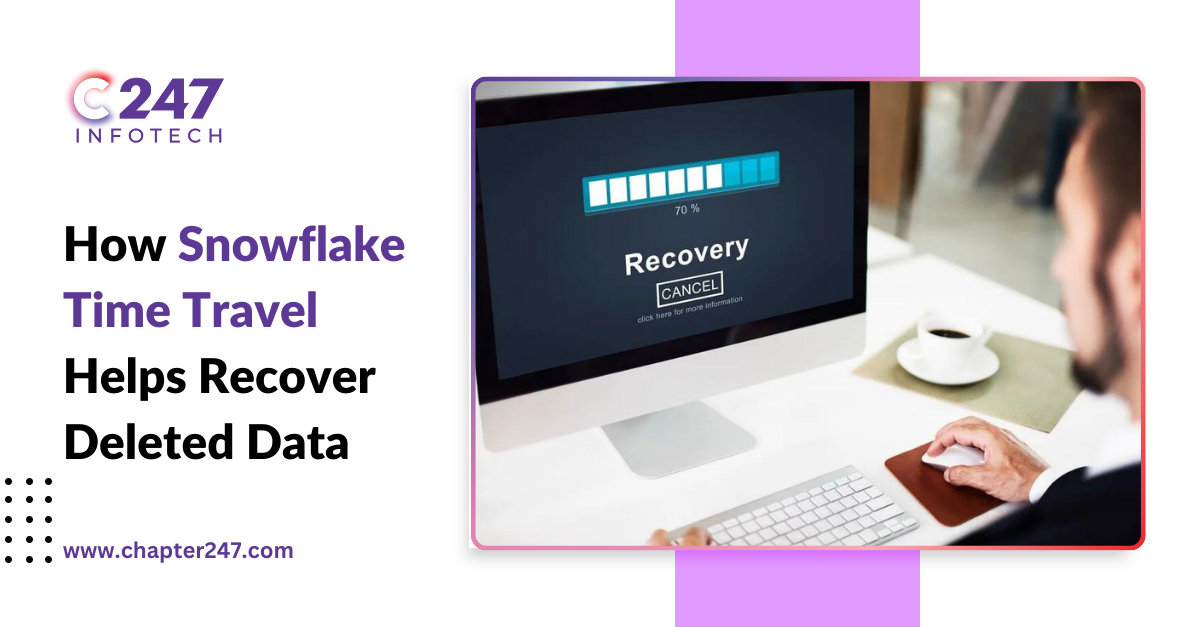According to TPX, about 35% of companies perpetually lose data and are unable to recover it. Imagine you dropped the table by accident or modified every entry rather than removing a particular set of entries. How are you going to respond? How are you going to recover your previously erased or edited data?
You must wish that you could go back in time and fix statements that were performed wrongly. Snowflake’s time travel function allows you to get the data that was available at a specific moment in time.
Understanding Snowflake Time Travel
A helpful technology that lets users recover deleted data (data that has been changed or deleted) at any point in the past is called Snowflake Time Travel. It is an effective Continuous Data Protection (CDP) function that guarantees historical data availability and upkeep. It helps you with:
- Query Optimization: Since Snowflake uses Clustering and Partitioning to optimize queries on its own, users don’t need to worry about query optimization.
- Safe Data Sharing: Information may be safely transferred between accounts by using Snowflake Database, Tables, Views, and UDFs.
- Support for File Formats: Snowflake can import nearly every file format, including semi-structured data formats like JSON, Avro, ORC, Parquet, and XML. Column type – Variant allows the user to store semi-structured data.
- Caching: Because Snowflake maintains query results in a cache for a particular session, its caching method gives results in repeated requests.
- Fault Resistant: Snowflake offers remarkable fault-tolerant capabilities to recover tables, views, databases, schema, and other elements in the event of an event failure.
How Does It Work?
The duration of the time travel window that was in place at the time of deletion is used for a deleted table or dataset. Tables that have been deleted before a change in the time travel window duration, for instance, are still only recoverable for a period of two days if you start with a two-day window and extend it to seven days. According to TPX, errors or misuses by humans, including social engineering, account for 74% of data breaches.
In a similar vein, tables that were deleted before the modification remain recoverable for five more days if you have a five-day time travel window and decide to shorten it to three days. You cannot modify the time travel window to recover deleted data until it is undeleted because time travel windows are configured at the dataset level.
How To Start Your Journey With Snowflake?
If you don’t already have an account on Snowflake, start by making one. Go to the Snowflake webpage and complete the registration procedure there.
After successfully completing the registration process, create a virtual warehouse in Snowflake. You can use this virtual warehouse as a computing resource for data processing and querying.
The connection details for your account can be found in the Account section or dashboard of your Snowflake account. This contains the role, password, username, and URL that you’ll need to log into Snowflake.
Benefits of Using Time Travel for Data Recovery
There are numerous advantages to employing Snowflake Time Travel. First and foremost, it offers a strong solution for data audits. By maintaining a history of all data modifications, you can simply monitor who made changes and when. This is very helpful in sectors like banking and healthcare, where data traceability and integrity are critical.
Data compliance also heavily relies on time travel. Several data regulations require businesses to keep a record of all data changes for a specific amount of time. It’s easy to follow these rules when you have time travel. You can quickly show auditors that you have access to the complete history of data modifications.
Disaster recovery is yet another essential advantage of time travel. Recovering deleted data or altering it by accident can have severe consequences, mainly if the data is vital to your company. Time travel reduces downtime and data loss by enabling you to return data to its prior condition swiftly. According to TeleData Select, a data breach’s average cost increased to $4.45 million in 2023 from prior years.
Conclusion
With Snowflake, enabling time travel is simple and can be set up at the database level. The time travel retention duration can be specified when a database is created or modified. How far back in time you can query historical data depends on this timeframe. Retention for time travel can be configured for hours, days, or even indefinitely. Learn more about time travel with Chapter247 and never regret deleting the data.








